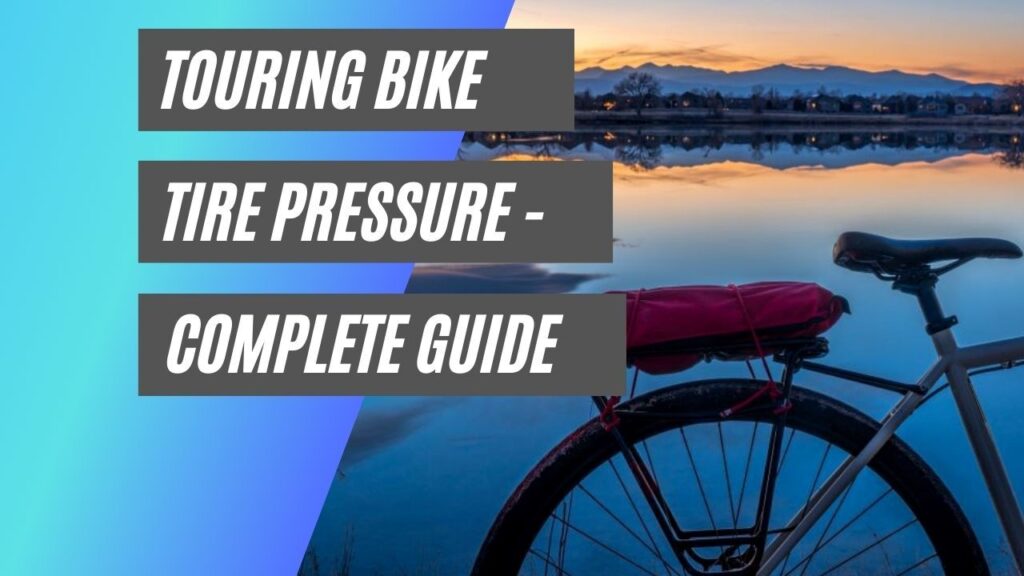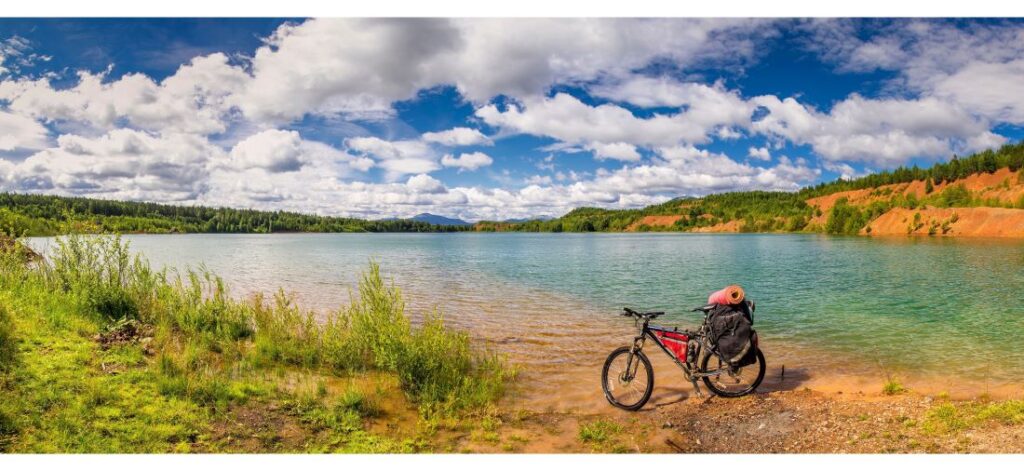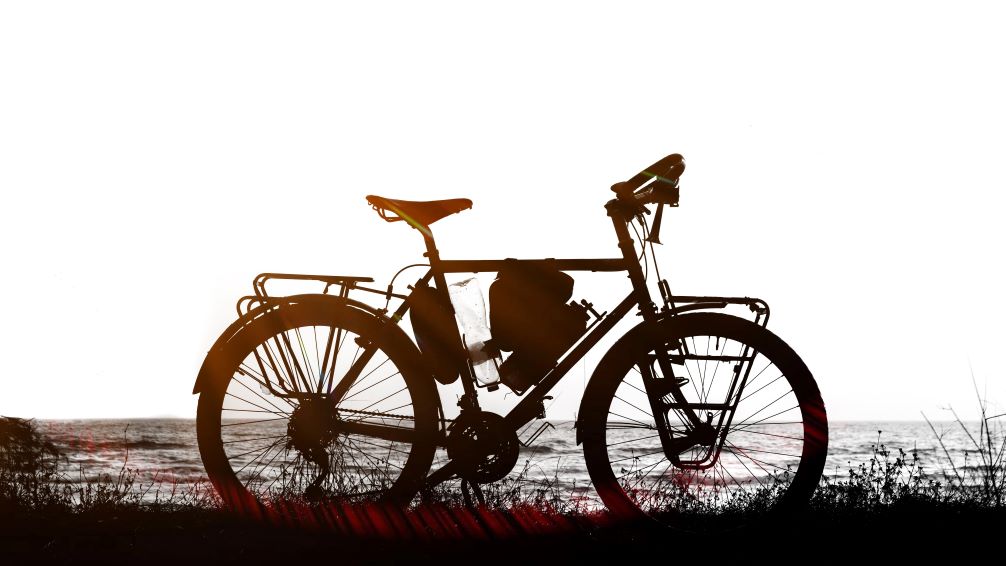This post may contain affiliate links. If you click an affiliate link and make a purchase, I may earn a commission. Also, as an Amazon Associate, I earn from qualifying purchases.--
There used to be a time when you’d just pump the tires of your touring bike, and that was all. But, with modern advancements, newer discoveries into the subject of tire pressures have been made. Now, in general, the single most impactful improvement you could make to a bike is its tire pressure.
What’s The Best Tire Pressure for a Touring Bike?
For a typical 1.75-inch wide tire, I suggest a front tire PSI of 55 and a rear tire PSI of 65. The general trend is usually to increase the pressure for thinner tires and decrease for wider ones.
These pressure ranges are usually for a relatively smooth tour route. However, I recommend increasing or decreasing the pressure relatively on smoother or more technical paths, respectively.
In this guide, I’ll go through exactly the tire pressure you should be looking for with a touring bike, all the factors to consider, and how to get the best out of your tires.

Touring Bike Tire Pressure
To be specific, you don’t want to set your tire pressure too high as that can cause discomfort.
On the same note, a tire pressure that’s too low can cause too much resistance and drastically slow down your bike. So, you need to find the best pressure between the two; somewhere in the middle.
The standard psi for most touring bicycle models is somewhere in between 50psi and 75psi.
Most models and tires will suggest the perfect psi for that particular brand (although there are other factors involved – see below).
Tire Pressure – How to Adjust Depending On Your Circumstances
Here are a few key facts to understand how you may change the tire pressure for your advantage:
Pneumatic Tires Explained
On practically any vehicle, pneumatic tires are supported by the pressurized air within an airtight chamber.
Under these conditions, a higher PSI (pounds per square inch) would simply make the tire harder. Vice versa, a smaller PSI makes a tire softer- pretty straightforward.
On the same note, if you’re trying to find the perfect PSI, it would vary depending on the bike.
Whether it’s a gravel, mountain, cyclocross, or road bike, every tire tends to have its own requirements. However, on the plus side, the recommended PSIs for these bikes can usually be found stamped on the sidewall of the rubber.
Here is an average psi recommendation for each type of popular bike:
| Type of bike | Recommended psi (for a rider of average weight) |
| Mountain bike | 25psi to 35psi |
Fat bike | 12 psi to 20 psi |
| Road bike | 80psi to 120psi |
| BMX bike | 70psi to 100psi |
| Cruiser bike | 30psi to 50psi |
| Touring bike | 50psi to 75psi |
Grip Level
Grip level influences what the tire can conform to on the surface.
In general, the more contact you have with the ground you’re rolling over, the higher the grip level. Over-inflated tires tend to bounce off surfaces as they only have a central strip for their grip.
Rolling Resistance
Rolling resistance is the friction formed between a tire and its surface. Put simply, resistance increases with contact, consequently growing friction.
If you have an underinflated tire, this encourages too much surface contact. This results in too much rolling resistance.
Yet, at the same time, it’s worth mentioning that an overinflated tire can also increase rolling resistance. This is because you’d constantly be bouncing off the surface, inhibiting a smooth and calming ride.
As a result, it’s crucial to find a delicate balance between these two extremes.
Pumping Air into Your Tire
With the appropriate tire pressure, you can roll and avoid flats quicker, smoother, and better than ever before. However, not all tires are the same. For example, narrower tires entail higher air pressures than wider ones.
These could include road tires that typically need about 80 to 130 psi (pounds per square inch), which is much more than the fat tire alternatives of the mountain (25 to 35 psi) or hybrid (40 to 70 psi) bikes.
So, if your tires don’t already indicate ideal pressures, you can simply find them by comparing your bike to typical ranges.
In particular, you can start in the middle of any of these ranges and then factor in your body weight. As you would expect, the more you weigh, the higher the tire pressure.
For instance, a 165-pound load often correlates with 100 psi on a road bike. But, for 200 pounds, you may expect about 120 psi.
In any case, just don’t over or below the recommended tire pressures on your touring bike.

What Factors Could Affect The Ideal Tire Pressure?
Tire Width
One of the more determining factors for tire pressure is width. To be more specific, the width of a tire is very dependent on the air chamber and the general size of the rim width and tire itself.
In general, wider tires result in lower ideal pressures.
Type of Tires
So, if you’re trying to determine your own ideal pressure, this is immensely dependent on the bike’s specific construction.
For example, cotton casing tires would deform and behave much differently than nylon tires. On the same note, TPI (Threads per Inch) can make a huge difference, as it entails a finer yarn – the higher the TPI, the smoother and faster the tire.
Rider’s Weight
These can all benefit from calculating an ideal tire pressure.
For instance, a 220-pound cyclist riding their bike on the smooth roads of Mallorca would need a higher tire pressure than a 132-pound cyclist going through the rutted and technical lanes of the UK.

Tire Pressure Factors to Consider For Your Touring Bike
Tire Durability
You should remember that higher tire pressures result in more durable bikes.
In general, bikes going on tours for over 20,000 kilometers function at relatively higher pressures. This is because they aren’t meant to last for longer distances without the need for puncture repair.
Comfort
With lower bike pressures, you’re guaranteed comfort. So, considering the time you spend sitting while riding on tour, this attribute would help drastically with the sluggish bike feel.
To be specific, lower pressures can help balance your comfort and overall speed.
Speed
Speed is more of a two-way street. In one case, smooth roads would need higher pressures as they create less resistance. However, other studies may also suggest that lower pressures can be effective. But, the efficiency is more helpful in technical terrains.
Puncture Resistance
With higher tire pressure, you wouldn’t have to deal with obstacles while on tour. Your tire would simply suck up any sharp objects, such as thorns, glass, etc.
So, I suggest that maximum tire pressures often work best for smooth road touring.
However, the context changes when considering off-road riding. In these cases, if you’re traveling on a loaded touring bike, you’re more likely to experience a pinch flat with low tire pressures.
Vice versa, higher pressures may result in wrist jarring or sores. The only solution, in this case, is to find an ideal middle ground based on the road’s surface.
Checking Your Tires
When it comes to tires, leaks aren’t uncommon. Now, though you have found and set your tire to the ideal pressure, there’s no way to ensure it stays that way without regular maintenance.
Depending on the type of tires, these leaks occur much more frequently in some tires than in others. Such as, with a proper tubeless tire or butyl tire setup, leaks are far less common than a typical lightweight latex tube.
With that being said, air would always seep out from any tire. This charge varies depending on the tire and conditions; it could be just a few psi per week or an extreme change overnight.
And, this rate of loss would only increase with pressure and reactions to colder temperatures (drops by 2% for every 10-degree decrease in Fahrenheit).
As a result, you’d find that many bicyclists check their tire pressure before every ride or at least once a week.
In general, it’s just crucial to develop a habit for regular checkups and top-offs. Without this mechanism, your tire pressure would most often be wrong.
Likewise, I recommend checking pressures the day after repairing a flat with a CO2 canister. Specifically, carbon dioxide is highly soluble in butyl rubber.
This causes it to hastily permeate through the tube walls of these tires.
In addition, if you flat early during a long ride and use CO2 to fix the leak, chances are you’d have to regularly check your tire in an hour or so. In most cases, these fixes tend to require topping off.
The Bottom Line
With all that being said, adjusting your tire pressure would always have clear benefits to your ability. In general, cyclists utilize this to adapt to diverse terrains: lower PSI for rough terrains, higher PSI for smoother roads, etc.
You should just remember that air is free, so there’s absolutely no harm in you taking complete advantage of it when you’re heading out for a ride.
